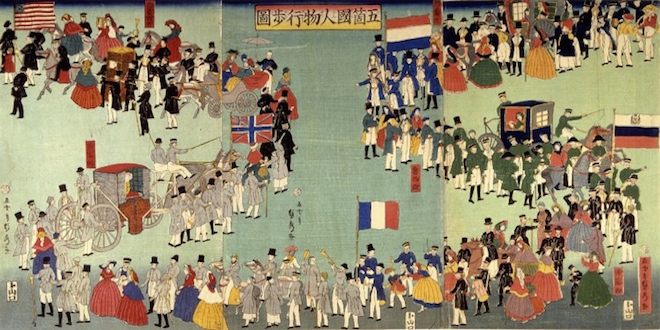Das ethnische Separieren im Nahen Osten
upg. Infosperber hat bereits mehrere Beiträge von Professor Joshua Landis übernommen. Schon früh hat der Nahost-Spezialist vorausgesagt, dass Syriens Präsident Assad sich noch länger an der Macht halten kann. In seiner neusten Veröffentlichung vergleicht Landis die Entwicklung im Nahen Osten mit der früheren Entwicklung in Osteuropa.
—
The Great Sorting Out: Ethnicity and the Future of the Levant
I believe that the best historical European comparison to what is taking place in the Middle East today is Eastern Europe, which was multi-ethnic and multi-religious. Much of it was part of dynastic empires, much like the Levant: a multi-religious/ethnic part of the Ottoman Empire. Perhaps the single greatest outcome of WWII in Europe was the creation of nation states that were more ethnically homogeneous than ever before. Tony Judt writes:
At the conclusion of the First World War it was borders that were invented and adjusted, while people were on the whole left in place. After 1945 what happened was rather the opposite: with one major exception boundaries stayed broadly intact and people were moved instead…. he term «ethnic cleansing» did not yet exist, but the reality surely did — and it was far from arousing wholesale disapproval or embarrassment.
Poland was 68% Polish in 1938. By 1946 it was overwhelmingly Polish. Germany was nearly all German. Czechoslovakia, which was populated by 33% minorities, including Germans, Hungarians, Carpathian Ukrainians and Jews before the war, shed this third of its population. One can go down the line of Eastern European countries, Hungary, Ukraine, Bulgaria, Romania and find the same ethnic cleansing and great sorting out. Thirteen million Germans were expelled or transferred from the Eastern European countries between 1945 and 1947. They had lived in these countries stretching from Poland in the north to the Ukraine and Romania in the South for hundreds of years.
Central European nation states were tidied up and their peoples rearranged according to nationality. Unlucky nationalities, such as the Jews and Gypsies that had no homeland, were in some cases exterminated. This is what is going on in the Levant. For example, the Jews, who used to be scattered throughout the Middle East, were driven out of their native cities (the Jews of Baghdad in 1918 were the largest religious community in the city). They have collected in Israel, from which they expelled the Palestinians.
Christians have all but disappeared from many countries of the region. Anatolia was 18% Christian in 1914. By 1922 they constituted less than 1% of Turkey’s population. In Palestine and Iraq, their populations have been decimated by nationalist foment and religious intolerance and discrimination. They same thing is happening in Syria to Christians today. I will not be shocked if by the end of troubles in Syria, the 20% religious minorities have been driven out and the 10% Kurds have joined their brethren in Iraq to form an independent nation. The Alawites today are behaving like the Germans of the Sudetenland during the first years of the war. But it is altogether imaginable that their time will come, when they will be treated like the guilty minority of Germans in Czechoslovakia.
It is easy to push the analogies between Central Europe between the two wars and the ex-Ottoman lands of the Levant too far. But I see a very clear process of nation building in the region. It is brutal to all, but particularly to the nationalities that do not find a home in one of the «artificially» created states. The problem with multi-ethnic empires is that there are no «natural» or «organic» borders. Whatever borders are drawn to make way for nation states, they will be unjust to many.
Because this is a «Lebanese» blog, it is only natural that I should try to fit Lebanon, where I lived 8 years of my humble existence, into this model. Lebanon has not built a better nation. Its three major ethnic groups – Shiites, Sunnis and Maronites – have not settled their national problem. Are they all Lebanese and one ethnicity, divided only by religion? Or are they three distinct ethnic groups? We don’t know yet. We hope they will resolve their differences, but it is not at all certain that they will. The balance of power between the groups makes ethnic cleansing impractical.
The Syrian occupation forced the Ta’if Accords on the warring factions, after taking their guns from them. What will the largely Sunni influx of Syrians do to the balance? Will the smaller minorities – Armenians, Alawites, Palestinians, Jews, Protestants, etc be driven out or assimilated? We must all hope that Lebanon figures it out eventually and provides a liberal model for the other Levantine states. So far it isn’t working out so well, despite the rosy predictions of some who believed that the Lebanese consociational model would catch on in Iraq and then the rest of the region.
In sum, we are witnessing the rearrangement of populations in the region to better fit the nation states that were fixed after WWI. Some new borders are being drawn, such as those around the Kurdish regions of Iraq and perhaps Syria, but mostly, what we are seeing is the ethnic cleansing of much of the region to fit the borders.
—
Themenbezogene Interessenbindung der Autorin/des Autors
Joshua Landis ist Professor für Internationale Beziehungen und Direktor des «Center for Middle East Studies» an der University Oklahoma, USA. Landis spricht fliessend Arabisch, Französisch und Englisch. Seine Familie lebte zuerst in Saudiarabien und im Libanon.









